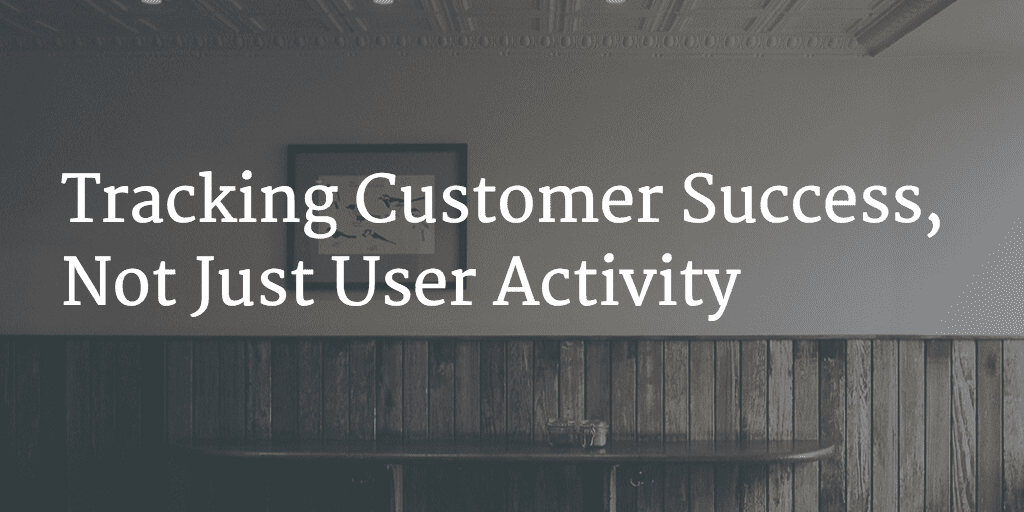There’s an awful lot of talk these days in the Customer Success community about tracking. Tracking activities. Tracking product usage. Tracking customer engagement. Tracking survey scores. Tracking, tracking, tracking. Not that there’s anything wrong with that. Customer Success is dependent on data, which obviously needs to be tracked, gathered, and turned into information. I don’t think anyone argues with that general approach. What I’d like to argue in this post is that we may be too focused on tracking activities and not focused enough on tracking real success.
What does it mean to track Customer Success?
This, of course, leads to the question – “What does it mean to track success?” For most software applications, there is a clear answer to that question. It lies in the ROI calculation. Let’s explore a simple example to illuminate this point. Say we have created a financial application that produces critical month-end reports and that each report, when done manually, takes two hours to complete. But, with our application, it’s a simple push of a button. So, in this oversimplified scenario, every time the “Create Report” button is clicked, two hours of effort are saved.
In the current noise of Customer Success applications, and arguments, the discussion about this application would most likely be about whether clicking the “Create Report” button is sticky, whether it’s a leading or lagging indicator, and whether it is a predictor of churn. Instead, it seems that we could look at this in a much simpler way and report on it accordingly.
Tying Activity to Customer Success
How about if the number of times the button is clicked is simply logged and a calculator multiplies those clicks by $300 to yield a “money saved” result? Wouldn’t this be much more valuable and powerful than simply tracking the number of times the button is pushed, what the trend of pushing the button is, whether the power user pushed the button, or whether the last 10 customers who churned ever pushed the button?
True, that’s a primitive example but the point is obvious, isn’t it? If we’re building applications that truly have an ROI associated with effectively using them, we should be able to track and report on that level of success in some way. And a good Customer Success application should help with that process. In a high-touch world where a CSM is doing quarterly business reviews and discussing actual success with each customer regularly, the ability to show actual ROI quarter to quarter is the ultimate dream. Even in a low-touch scenario, you should be able to automate the reporting of success back to the customer through email campaigns or in-app reporting. Nothing would reduce churn more than proving the ROI of your application to each customer in an agreed-to and repeatable way.
Tying ROI to Customer Success
Now obviously I’ve painted an ideal picture and we live in a distinctly less-than-ideal world. But, virtually every application does have an ROI calculation that is part of the Sales conversation. And those ROI calculators are not at all effective unless the prospect has agreed to the underlying assumptions. The same process can then be used post-sale, to prove the ROI. In our financial application example, we’d need to sit down with the customer and confirm that they would indeed save two hours every time a user creates one of those reports. If that was their assumption when they bought our app, it’s highly likely they’ll agree to it as a measurement going forward.
It’s important to remember that our buyer, and/or our key users, wants to be able to prove the ROI of our app just as much as we do. Anything less will make the purchase look like a bad decision. In addition to putting our renewal at risk, it may very well put our champion at risk, too. This is why I think we’ll find our customers quite open to having this conversation and helping us prove our application’s value.
Tracking Customer Success Includes Tracking User Activity
So, let’s take them up on this challenge and start tracking success, not just activities. The more we do this, the fewer questions there will be about the value of our application and the overall value of Customer Success applications. Think about the potential power of your solution if your Product team is seriously considering the trackable ROI of every feature they build. It’s the existence, and proven functional value of Customer Success applications that will make this dream a reality. Today, this is what is driving the increased instrumentation in many applications. Tomorrow, perhaps that instrumentation will be more focused on true success, not just activity reporting. That will be a win-win proposition.

